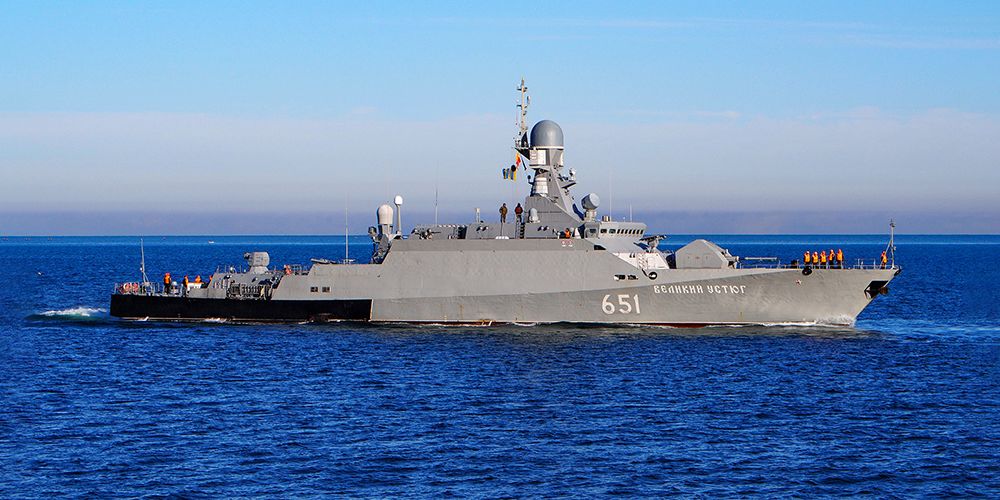Search

Publications
Caspian Flotilla: current status and prospects for development

The Caspian Flotilla (CFl) is one of the oldest of the Russian Navy's current formations. In terms of «age», it is second only to the Baltic Fleet. On November 15 this year it celebrated its 300-th anniversary Ц in November 1722, by decree of Peter the Great, a military port was founded in Astrakhan and a military flotilla was formed.
Glorious history Ц valiant present
The Russian Caspian Flotilla has always had a dominant position in the operational theatre. That said, some saw it as a kind of «appendage» to the larger Russian/Soviet fleet, operating in the world's oceans, rather than in an isolated water area. However, actual practice has shown the fallacy of such a view. During the Great Patriotic War ships of the flotilla, repelled raids by Nazi aircraft and escorted tankers from Baku to Astrakhan and ships from Iranian ports carrying lend-lease shipments, much needed by the front. The Caspians represented a significant proportion of the crews of the Volga Flotilla that fought for Stalingrad. Ships and submarines were tested in the Caspian and then sent to the Northern, Baltic and Black Sea Fleets. That is why the «peripheral» formation was awarded with the Order of Red Combat Banner for its valiant actions during the Great Patriotic War.
The Caspian flotilla has brilliantly proved its worth in modern times. It were the Caspians who demonstrated the power of the Kalibr-NK missile system first in the autumn of 2015, unleashing this high-precision weapon on key terrorist targets in Syria. The flagship of the formation, the Dagestan missile ship, as well as project 21631 Bayan-M fast attack missile crafts are capable, if necessary, of hitting targets not only in the Middle East, but also in the Trans Caucasus, Central Asia and Eastern Europe. They have demonstrated their striking power on more than one occasion during the special military operation in Ukraine. —Fl ships have been on combat duty to the Black Sea and the Mediterranean on more than one occasion.
The Tatarstan and the Dagestan Ц are flagships of the Caspian Flotilla
Nowadays, the Russian Navy's Caspian Flotilla includes two 2-nd rank missile ships (they are also classified as patrol ships) of Project 11661K with a total displacement of 2,200 tons and length of 102.2 meters. And although they share a common project number, the missile ships differ from each other.
The Tatarstan, which entered service in 2003, was the first major ship of the new design to join the Russian Navy in the post-Soviet period, is armed with two quadruple launchers for the Kh-35 and the Kh-35U anti-ship missiles of the Uran complex with a range of 130 and 260 km, respectively, the Osa-MA-2 SAM system, 76 mm AK-176M multi-purpose artillery mount and two 14.5 mm machine guns, launchers for the PK-10 Smely electronic jamming system.
The Dagestan, which entered service in 2021, features a «stealth» design, while the Uran shipborne missile system was replaced with the Kalibr-NK in a 3S14 universal vertical launcher with eight missiles designed to hit seaborne targets at a range of 375 km, and coastal targets at a range of over 1600 km. As a replacement for the Osa-MA-2 SAM system, the ship is armed with the Palash AAA system. The radar equipment has also been upgraded.
This metamorphosis is for a reason. The Zelenodolsk Design Bureau, the developer of Project 11661, has designed a flexible platform on the basis of which ships of various types and classes can be built. For example, a series of multipurpose Project 11661E Gepard frigates were built for the Vietnamese Navy at Zelenodolsk Shipyard named after A.M. Gorky, which is now part of the Ak Bars Shipbuilding Corporation. Gepard frigates are designed to combat surface and underwater enemy targets, including with the use of the Ka-27PL deck-based helicopters.
The Tatarstan and the Dagestan, which are both equipped with advanced radio equipment, are used as flagships of the flotilla.
The Buyan (brawler) family
Three project 21630 Buyan small gunnery ships (SGS) developed by the Zelenodolsk Design Bureau are successfully operating as part of the Russian Navy's Caspian Flotilla. As a matter of fact, they are modern gunboats, designed to engage coastal and seaborne target. Over the years of service, the Astrakhan, the Volgodonsk and the Makhachkala SGS have demonstrated high nautical and maneuvering qualities. With gross displacement of 560 t, length of 61.45 m and beam of 9.6 m, they can reach maximum speed of 26 knots, using diesel engines operating in CODAD arrangement and water-jet propulsion reducing noise and sailing vibration. Stealth technology is widely used on ships, making them low-visible. For example, inclined flat surfaces of the superstructure and gun turret, hull side skirts contribute to the scattering of reflected radar waves and reduce their intensity, i.e. the secondary radar field of the ship. The layout of rooms and corridors facilitates free movement of personnel around the ship without having to enter the upper deck. Upon alarm, every officer and sailor can quickly take place according to the battle bill.
The range of Buyan class ships is 1,500 miles and sea endurance is 10 days. The navigation system and meteorological support equipment, the Sigma combat information and control system, and the integrated bridge system are fully up-to-date and enable to carry out combat missions to the fullest extent and to navigate safely. Thanks to the widespread introduction of automation, the number of crew members is as low as 29-36. The Buyan class ships meet the requirements of the International Convention for the Prevention of Marine Pollution (MARPOL 73/78) and the Vienna Convention for the Protection of the Ozone Layer of the Earth.
A 100 mm AK-190 universal automatic artillery system, designed to engage seaborne, coastal and air targets, is located in front of the wheelhouse of Buyan ships. Firing is controlled by the 5P-10-03E Laska-M system with radar and opto-electronic channels. In terms of firepower, the AK-190 outperforms the renowned Italian OTO Melara 76 mm ship-mounted gun, and in most performance aspects Ц the French Creasot-Loire Compact 100 mm gun. The rate of fire of A-190 is 80 rounds per minute. The gun delivers a 15.6 kg shell at a range of up to 20 km. The weight of the system itself is less than 15 tons.
The MS-73 launcher of the A-215 Grad-M system, designed to engage area-type coastal targets, is installed in the aft. This weapon needs no special introduction as it is a redesigned maritime version of the famous Grad Multiple Rocket Launcher System (MLRS). Salvo of two 20 launch tube packs of 9M22U 122 mm projectiles can reduce any target to dust at a range of 5 to 20 km and clear a beachhead for a successful amphibious landing. New homing sub-warheads have been developed and tested for the MLRS, further enhancing its effectiveness.
The main anti-aircraft weapon of the Buyan ships is the 3M-47 Gibka turret, which uses the Strelets SAM module with Igla and Igla-S missiles with infra-red seeker. There are 4 missiles in the module. Firing is performed on a «fire and forget» basis with single missiles or a salvo of two. Targets are hit at ranges of 500-6000 m and at altitudes from 5 to 3500 m. The complex is designed not only for air strikes, but also for small-sized surface targets.
The Buyan ships' air defense is complemented by two six-barreled automatic 30 mm AK-306 artillery mounts and a pair of large-caliber 14.5 mm MTPU machine guns mounted on both boards on the superstructure behind the wheelhouse. They are also used to engage surface and coastal targets. There are pedestals in the aft and in the fore for three 7.62 mm machine guns. In addition, a retractable Anapa-M hydroacoustic station to detect underwater saboteurs and a DP-64 grenade launcher to destroy them are fitted as part of the equipment.
There is a rigid inflatable speedboat with an aluminum alloy bottom on a sloping, drop ramp-covered slip in the aft area. It is designed for rescue of persons in distress on the water, search operations, landings of reconnaissance and sabotage teams.
To increase the effectiveness of the air defense system, two PK-10 jamming units are mounted on both boards in the aft section of the Buyan ships behind the superstructure. In the event of a threat, they fire decoys that interfere with the opto-electronic seekers of the enemy's air attack weapons and divert them away from the ship.
The Project 21631 Buyan-M fast attack missile craft are a further development of the Buyan gun boats. Their total displacement increased to 949 tons and length Ц 74.1 meters. The range at 12 knots also increased to 2,500 miles. And the crews range from 36 to 52, depending on the mission.
The most significant changes concerned armament. In addition to 100-mm A-190 artillery mounts and machine guns, a universal vertical launcher 3S14 with eight Kalibr-NK missiles for engaging seaborne and coastal targets was added to the Buyan-m and mounted behind the wheelhouse. The anti-aircraft armament of fast attack missile crafts has also been enhanced. A second launcher, the Gibka with MANPADS, and a 30 mm AK-630M-2 Duet twelve-barrel mount, with a rate of fire of 10,000 rounds per minute, have been added and mounted closer to the aft. Duet is designed primarily to engage low-flying anti-ship missiles of the enemy, as well as any airborne targets within a range of up to 5,000 m.
After the lead ship in the series, Grad Sviyazhsk (commissioned in 2014), the Caspian Flotilla received fast attack missile crafts Uglich (2014) and Velikiy Ustyug (2015).
In 2014, the then Caspian Flotilla commander Vice Admiral Sergey Alekminsky stated that the flotilla would have six project 21631 fast attack missile crafts by 2016. But that never happened. After construction the Zeleny Dol and the Serpukhov fast attack missile crafts were sent to serve in the Black Sea and then, after sailing around Western Europe, moved on to the Baltics.
The highly successful Project 21631 Buyan-M project fast attack missile crafts have proven to be the most in-demand surface vessels in the Russian Navy. The Vyshny Volochek, the Orekhovo-Zuyevo, the Ingushetia and the Grayvoron all «got registered» with the Black Sea Fleet. The Grad, which is completing tests in the Baltic, will remain there. The Naro-Fominsk that is under construction at the A.M. Gorky Zelenodolsk Shipyard, will also stay there. Only the Stavropol is scheduled for delivery to the Caspian Sea in 2024 so far.
At the Army-2022 forum, the Ak Bars Shipbuilding Corporation demonstrated a model of the Project 21635 fast attack missile craft with a total displacement of 1,400 tons. This is an enlarged version of project 21631. The underwater hull will be V-shaped to improve seaworthiness and the water-jet propulsion system will be replaced with propellers. Operational stock of Kalibr-NK cruise missiles will increase to 16. But it is not yet clear whether such ships will be ordered by the navy and whether they will join the Caspian flotilla.
What is the reason for the «move»
The Caspian Flotilla has, of course, been reinforced in recent years by more than small gunnery ships and fast attack missile crafts. Given the persistent terrorist threats, purpose-built ships were needed to neutralize sabotage attacks. In 2014 a special purpose boat, the Caspian Young Soldier, project 21980 Grachonok, designed by Vympel Design Bureau and built by A.M. Gorky Zelenodolsk Shipyard, joined the flotilla. With displacement of around 140 tons and a 23-knot full sea speed, it carries a variety of equipment to detect and eliminate underwater saboteurs and terrorists.
The boat, in particular, is equipped with a multifunctional optical-electronic television close air and surface environment illumination system MTK-201M3, a search and surveillance system Kalmar, which allows to survey the bottom surface at a depth of 200 m at speed up to 8 knots, MG-757 Anapa submersible hydroacoustic station for detection of underwater sabotage forces and equipment, Falcon teleoperated submersible vessel with operating diving depth up to 300 m. The Grachonok is also equipped with a shipboard diving complex with a pressure chamber.
The DP-65A ten-barrel 55mm counter-sabotage grenade launcher and the DP-64 45mm twin-barrel grenade launchers are used to engage underwater swimmers and their transportation gear. This arsenal is complemented by a 14.5 mm machine gun and the Igla man-portable air defense system.
Now there are three boats of the 21980 Grachonok project in the Caspian Flotilla. They guard the waters adjacent to the main naval base of Kaspiysk, infrastructure development of which began in 2017. Relocation of the main «nest» of the Caspian Sea from Astrakhan to Kaspiysk is due to the shallowing of the Caspian Sea, which is particularly noticeable in its northern part. As early as the mid-2000s, the largest ships of the flotilla preferred to moor in Makhachkala rather than in Astrakhan.
There is another reason for the relocation. Kaspiysk is more conveniently located and closer to the operational theatre in the Middle East region than Astrakhan.
Two Project 03160 Raptor boats are also used to guard Kaspiysk. With a total displacement of 23 tons, they reach a maximum speed of 48 knots. The wheelhouse with two workstations and controls is armored and the portholes are made of 39mm-thick, bullet-resistant glass. The Raptors' armament includes a 14.5 mm machine gun, the Uprva-Cord machine gun, and two 7.62 mm 6P41 Pecheneg machine guns.
Project 03160 boats are used as patrol and amphibious transport boats. They are capable of transporting 20 marines or special force troops up to 300 miles at 20 knots.
Deficiency in amphibious boats
The flotilla operates six project 11770 Serna air cavity landing craft developed by the R.E. Alekseev Central Hydrofoil Boat Design Bureau and constructed at the Volga shipyard in Nizhny Novgorod. With a total displacement of around 100 tons, these boats can carry 92 troops or one tank or two BMPs/APCs, or 45 tons of cargo at a speed of up to 30 knots.
In 2010, the flotilla was replenished with the air cavity landing boat Ataman Platov, project 21820 Dyugon, developed by the R.E. Alekseev Central Hydrofoil Boat Design Bureau. With gross displacement of 280 tons, length of 45 m and beam of 8.56 m, it can reach a maximum speed of 35 knots. The boat can deliver two tanks, four BMPs/APCs or 140 tons of cargo over 500 miles. It was supposed that the Caspian Flotilla would receive at least three more amphibious assault crafts of this design, but after their construction at the Yaroslavl shipyard, they were sent to the Baltics.
The Caspian Flotilla's need for Project 21820 Dyugon is estimated at several dozen units. Especially after the 414 and 727 Separate Marine Battalions of the Caspian Flotilla were reorganized into the 177 Marine Regiment.
At least a few medium amphibious assault ships, e.g. Project 21810 with a displacement of 1,740 tons, designed by the Northern Design Bureau, are needed to quickly deploy the full complement of marines ashore. With length of 97 m, width of 15 m, draft of 2.6 m and cruising speed of 18 knots, it can transport five T-72 tanks or 16 APCs and 170 marines, as well as up to 400 tons of cargo to the landing site. It is equipped with a helipad to receive helicopters. Medium landing ship carries two Project 22080 amphibious assault boats and two 17-meter transport boats. Armament includes a 57 mm automatic gun, two 30-mm automatic guns, two 12.7 mm machine guns in autonomous modules and eight Igla man-portable air defense systems. The ship can be fitted with a forty-barrel 122 mm Grad-M MLRS and a twenty-two-barrel A-22 Ogon 140 mm flamethrower to provide direct support to the amphibious assault troops.
So far, there are no such medium landing ships within the Caspian Flotilla. Their lack was evident in the Caucasus 2020 strategic command and staff exercise (SCSE). As part of these maneuvers, marines performed an amphibious assault on an unequipped coastline on the Caspian Sea near the Dagestan town of Zelenomorsk. This SCSE episode involved about 500 marines, 24 combat ships, auxiliary vessels and boats of the Caspian Flotilla and two border guard boats, BTR-82AM amphibious armored personnel carriers, Grad multiple-launch rocket systems, Sani mortar systems Ц over 40 units of military equipment in total. Air support was provided by two Mi-24 and Mi-35 helicopter gunship squads. After a barrage of gunfire, Mi-8 helicopters landed the advanced landing and assault groups of marines.
Events then unfolded in the following way. The BL-820 crew boat conducted mine reconnaissance at the water's edge, while on the approach to the shore, minesweepers operated from Project 23370 multipurpose search and rescue boats, primarily designed for operation in ports and at anchorage. Minesweepers also took part in the exercises Ц two harbor minesweepers RT-59 and RT-181 of 697TB design, built in Astrakhan on the basis of commercial fish boat in 1976 and 1980. They «cleared the way» for the main landing troops.
And all six Project 11770 Serna fast landing boats of Caspian Flotilla were used to deliver them ashore. Marines also landed from Project 1204 Schmel gunboats with a displacement of 77 tons. There are four of them in the Caspian Flotilla. They were built at the turn of the 70s of the last century.
A Project 20360 Dubnyak VTR-79 armament transport also took part in the amphibious landing. The vessel is designed for the storage, transport and transshipment of weapons. Its gross displacement is approximately 2,000 tons, length 61.5 meters, beam 15.7 meters, draft 3.1 meters, full sea speed more than 10 knots. Organizers of the Caspian Sea exercise used the ship to adapt it for amphibious activities. They placed several armored personnel carriers on the deck of the transport.
Refurbishment is required
We have already mentioned the project 697TBs RT-59 and RT-181 harbor minesweeper that took part in the Caucasus 2020 exercise. These vessels are obsolete. The first has served 36 years and the second Ц 32. Unfortunately, the RT-71 project 1258 Corund is also of a very venerable age. Two project 10750 river minesweepers, although younger, are not up to date with the current requirements for minesweeping equipment.
Two larger 1265 Yakhont coastal minesweepers, the German Ugryumov and the Magomed Gadzhiev, are also of venerable age and are equipped with obsolete mine countermeasures. Meanwhile, the special military operation (SMO) in Ukraine has once again demonstrated persisting dangers of mines. In the absence of harbor minesweepers, it took a great effort for the Black Sea Fleet to neutralize even very primitive anchor mines by modern standards, especially in the coastal zone. Therefore, the Caspian Flotilla, as well as other Russian naval formations, badly needs modern minesweepers, including coastal minesweepers capable of detecting and destroying the most sophisticated mines.
It should not go unspoken that during the SMO, the Caspian Flotilla became the reserve of the Black Sea Fleet. Most of the landing boats of projects 11770 and 21820, as well as gunboats of project 1204 Schmel were transferred to the Black Sea and Sea of Azov to carry out combat missions. The Marine Corps of the Caspian Flotilla also operates there.
The Schmel project boats should be mentioned in particular. These small lightly armored vessels have length of 27.4 m and beam of 4.32 m and are armed with a fore-mounted 76 mm artillery mount in the PT-76 tank turret, a twin 25 mm 2M-3M automatic gun and a seventeen-barrel 140 mm BM-14-17 MLRS with a firing range of 9800 m. Even a decade ago, these gun boats seemed like deeply obsolete monsters. But the fifty-year-old ships turned out to be very much in demand Ц for operations in the shallow waters of the seas and on rivers.
Gun boat crews do their best to keep Shmel project boats in good technical condition so they can perform combat duty. But, no doubt, they need to be replaced. What will the concept of prospective gun boats be? They should be equipped with powerful artillery systems, anti-tank guided missiles to engage seaborne and coastal targets, and modern MLRS with homing munitions. Finally, they should be armored to protect the crew.
The strike force of the Caspian Flotilla also needs replenishment. The matter is that RK 11661K and project 21631 fast attack missile crafts are a kind of battleships and cruisers of the Caspian Flotilla. But they need a combat guard. Especially in light of the fact that Russia's neighboring states in the Caspian Sea are building up the combat power of their fleets. Suffice it to recall that the number of anti-ship missile launchers on Turkmen Navy ships and boats is more than twice as high as the number of anti-ship missile launchers on Russian ships of the Caspian Flotilla.
The Caspian Flotilla has only one Soviet-built Stupenets project 1241-1T (12411T) Molniya missile boat, which is theoretically capable of performing combat patrol tasks.
It is true that the Caspian Flotilla has a powerful defense in the form of the 51 and 847 Separate Missile Divisions, armed with the Bal coastal missile systems with Kh-35 Uran anti-ship missiles. But they are deployed in the vicinity of Kaspiysk, that is, their radius of coverage is limited to 130 kilometers. That's why the flotilla needs small strike units capable of defending the main forces of the Caspian Flotilla in any area of the sea.
And there are facilities to accomplish this task. On the basis of MAK 21630, the Zelenodolsk Design Bureau developed two versions of Project 21632 Tornado small missile-gun ships. In the first, the A-215 complex MLRSs were replaced with the Uran anti-ship missile system (2x4). Anti-ship missile launchers are installed in the middle of the ship, and the 3M-47 Gibka turret launcher is relocated to the aft. The second version's main strike weapon is the Onyx supersonic anti-ship missiles (2x2) with a range of up to 300 km. The two launchers for these anti-ship missiles are «concealed» behind the casings, on both sides, closer to the aft. In all other respects the ship is identical to the Tornado of the first version. In both the first and second versions, operational range was increased to 2,300 miles compared to the Buyan. The use of unified platforms for project 21630 and 21632 ships will make their operation easier and cheaper.
An underwater menace in the Caspian Sea is becoming more and more evident. Iran is already capable of transporting its Ghadir class small submarines to this theater of operations from the Persian Gulf. Turkmenistan is taking a closer look at the small Turkish submarines. Meanwhile, ships and boats of the Russian Caspian Flotilla have no equipment for detecting and destroying submarines.
The enemy's experience in the use of unmanned aerial vehicles in the Black Sea during SMO should be studied thoroughly. In addition to low-visibility UAVs and unmanned motor boat, the use of unmanned undersea combat vehicles (UUCVs) is not to be ruled out. In case of their massive combined attacks the losses can be significant. That is why we have to be ready for any challenge.







